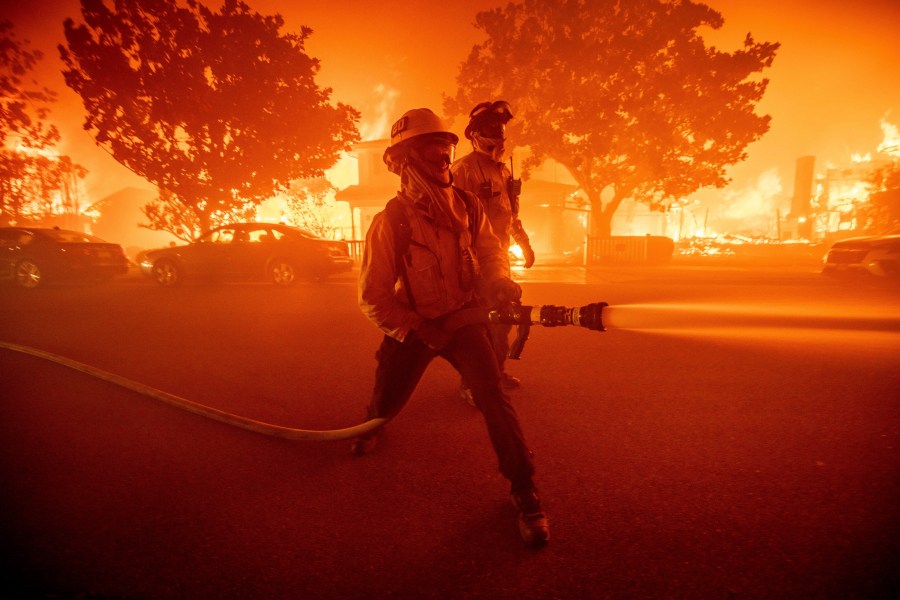As the Pacific Palisades burned during an unprecedented firestorm on Jan. 7, 2025, and the following days, concerns immediately turned to a lack of water in hydrants and a reservoir capable of holding 117 million gallons of water that was sitting empty.
KTLA has spent months obtaining public records from various agencies involved in the fires and the aftermath. At the center of some of the controversy and concern over hydrants running dry and the empty Santa Ynez reservoir: the Los Angeles Department of Water and Power (LADWP).
From documents recently obtained by KTLA, it appears the LADWP realized very quickly that it had a perception problem on its hands.
Jan. 11: Copy from LADWP was already showing up titled “correcting misinformation about LADWP’s water system… Any assertion that fire hydrants in the Pacific Palisades were broken before the Palisades fire is misleading and false.” The same memo went on to say that “LADWP was required to take the Santa Ynez Reservoir out of service to meet safe drinking water regulations.”
Jan. 12: A new update emphasized the water that WAS available, titled “supporting the fire response’… it said ‘over 8.5 billion gallons of water are available in LADWP’s open-air reservoirs, including Hollywood Reservoir, Lower Stone Canyon, and the Encino Reservoir. All have been used to directly support aerial firefighting efforts and continue to be available.”
Jan. 13: Public records requests were already arriving to the agency as news media sought answers into just WHY the Santa Ynez reservoir was empty as the Palisades burned.
Jan. 13: LADWP sent out a bulletin internally: “There has been a lot of misinformation spread on social media and in other media accounts about our wildfire preparedness and response. While we work to correct this misinformation and share information about the extraordinary work our employees are doing, we want to provide you with facts about our response that you can use as you speak with family, friends, and colleagues.”
Jan. 14: An internal email response to the team read: “The PIO team is doing an excellent job with the updates to the media/updates. It’s always a challenge to balance copy and operation direction with customer impacts. You’re an impressive team in the heat of fire (no pun intended, I promise). Keep up the great work.”

Included in the batch of public records—LADWP keeping track of public statements that seemed favorable to LADWP… (paraphrased below):
Chief Christian Litz, California Department of Forestry: “We did have water during this operation… If you can imagine how many structures were burning… we just outpaced the amount of water that any major water can supply so we had to use alternate tactics… DWP did a great job…”
Capt. Braden Silverman, LAFD: “City water supplies are just not meant to be able to supply the capacity needed to protect as many structures that were affected by this particular fire…”
Chief Anthony Marrone, LA County Fire: “Metropolitan water systems are not designed to sustain a firefight like this.”
Water expert David W. Pedersen: ”One of the basic functions of a public water system is to provide fire protection, and the purpose is to protect lives and structures. However, it is important to understand that public water systems are not designed to fight wildfires….”
As the LADWP tracked expert comments favorable to the agency, it also tracked “News Coverage of the Wind and Fire Response’… another 54 pages of documents obtained in the public records request… including Los Angeles Times headlines like ‘Why hydrants ran dry as firefighters battled California’s deadly fires” and a Wall Street Journal article “Fighting Fires—and the rumor mill— as LA Burns: skyrocketing misinformation is forcing public officials to adopt a new playbook when tragedies hit their communities…”
Just what else is in the documents? We may never know. KTLA received numerous pages marked “document withheld for deliberate process privilege.”
Or other exchanges—which were marked “exempt: A/C privilege”
Or still others—exempted for multiple reasons
As for the Santa Ynez reservoir, which sat empty during the fires, it was initially expected to come online in May. That was until new problems were spotted as the LADWP was refilling the reservoir.
As the Los Angeles Times reported, the LADWP said the reservoir needed to be drained again to make necessary repairs to the reservoir’s floating cover—and is now expected to come online sometime in June.
